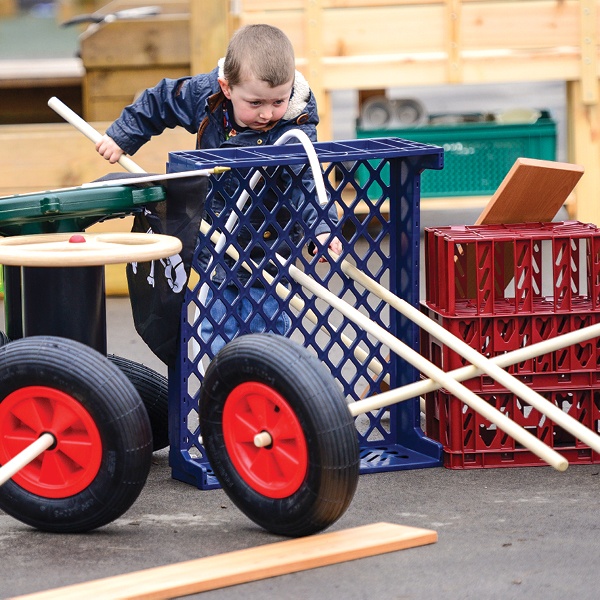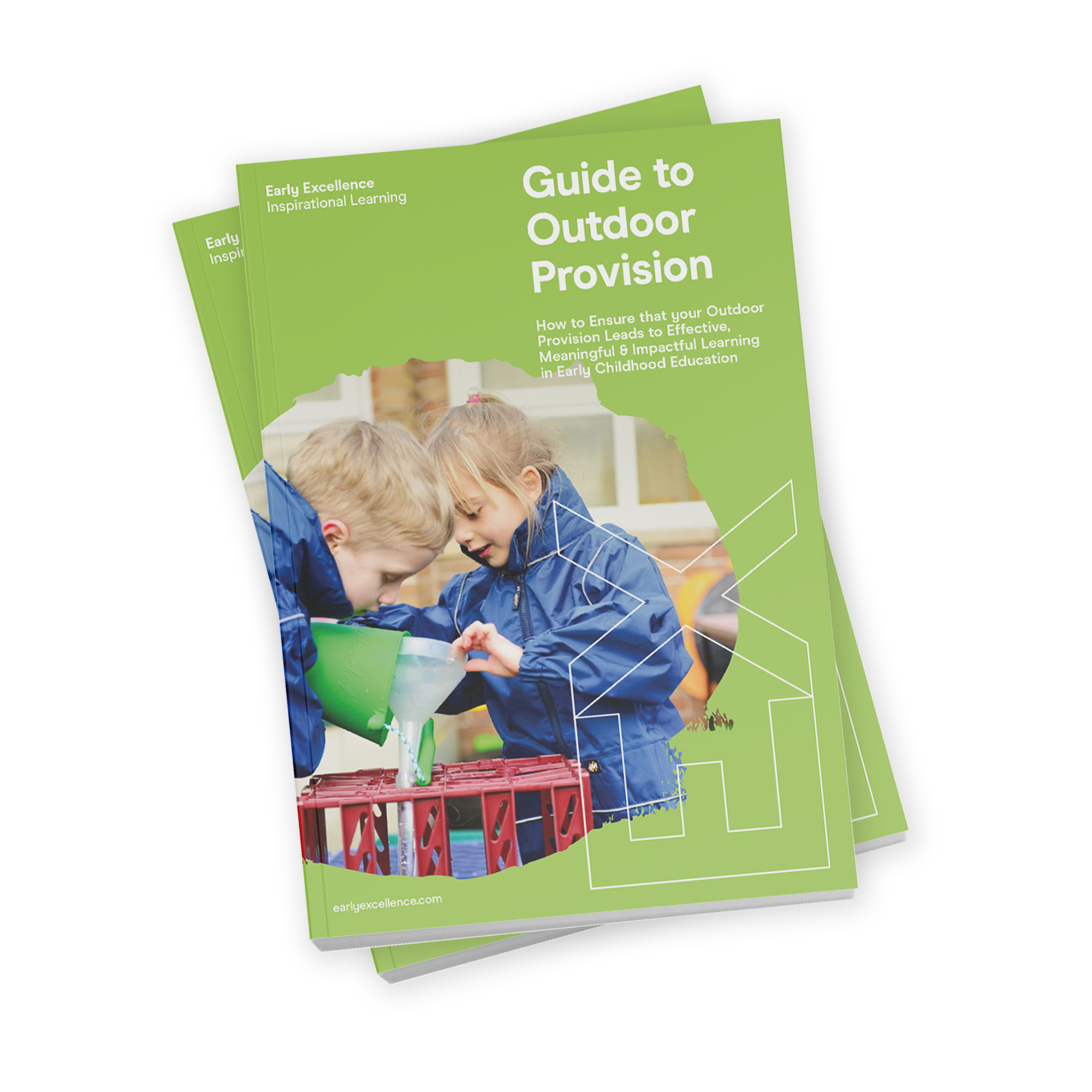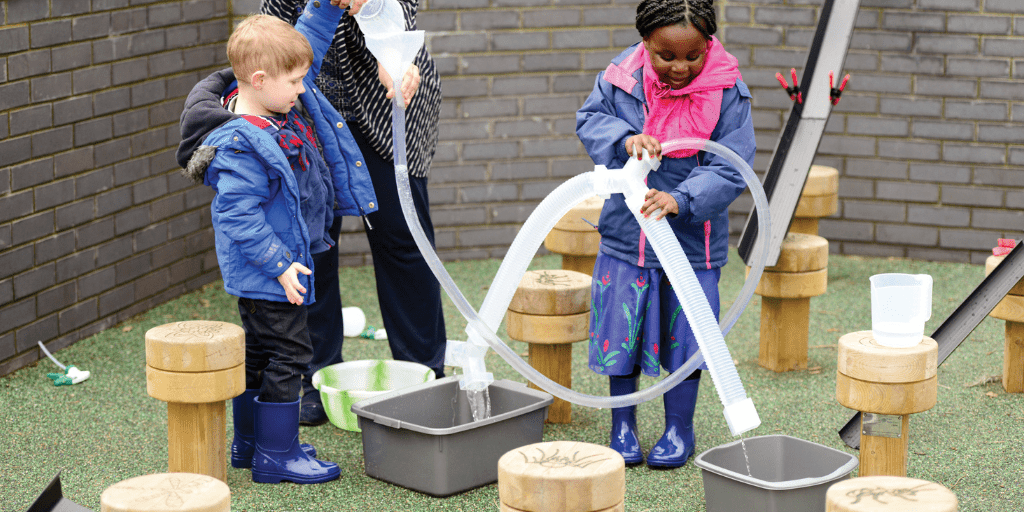This Maths Outdoors article is also available as a podcast:
When it comes to teaching and learning outdoors, this quote from the Professor Tina Bruce always comes to mind:
“Frequent lack of attention to the external environment must come from some bizarre assumption that knowledge acquired indoors is superior to that gained outside.”
Tina Bruce, Early Childhood Education
There’s more than an element of truth here: we do often spend far more time planning and preparing for learning indoors than we do outdoors. When discussing indoor mathematical learning, we focus on developing an effective maths continuous provision area and ensuring that other areas of provision are rich in opportunities for mathematical learning. When planning outdoor learning, however, we often miss the point: an outdoor area does not become mathematically rich with the magical addition of laminated numbers and shapes displayed on a fence or shed wall. If we are aiming for effective teaching and learning of mathematics outside, then we have to first appreciate the key differences between indoor and outdoor learning and understand the enormous potential the outdoors offers for developing mathematical thinking in young children.
So, let’s look at the mathematical possibilities of the outdoors in more depth by looking at three key areas of mathematical development:
- Exploring – seeking patterns, solving problems making connections, recognising relationships
- Talking – using mathematical vocabulary, generating questions, sharing and discussing ideas, predicting and describing outcomes
- Representing – exploring a range of graphic ways that ideas can be considered and communicated
Exploring Maths Outdoors
Learning outdoors is different to learning indoors. Outdoor spaces generally provide more space for physical activity and children will naturally want to explore outdoors using large physical movements. From the outset then, the materials that we provide need to be bigger and more physically challenging than indoors. Children will develop cognitively alongside the development of gross motor skills if we provide opportunities for this.
So, when planning and resourcing your outdoor space, THINK BIG! Large crates, planks of wood wooden poles, pegs and different fastenings will all lead to large construction with lots of learning potential. Also, think carefully about children’s predictable interests as a powerful motivator for learning. Children will want to create dens- large and small spaces of varying sizes for their imaginative play. For this they will need tarpaulins, netting and other materials. As they are creating their dens and enclosed spaces, they will be exploring size, scale, capacity, height, length and estimation. Importantly, they will also be working collaboratively. The size and scale of the materials will mean that children will need to often work together to achieve what they have set out to do. There will be a high degree of problem solving here too. This is the perfect context for seeing mathematics as meaningful, challenging and ultimately rewarding.
Water play outdoors will also provide endless possibilities for exploration and engagement with mathematical concepts, if we plan it carefully. Outdoor water play needs to be on a much bigger scale to the indoor equivalent and definitely does not need to be restricted to a water tray. Again, think carefully about the size and scale of what is on offer. Large buckets, jugs and watering cans (with different rose attachments) of different sizes and depths will all lead to exploration of capacity as children lift and transport quantities of water. Include pieces of guttering and tubing of different lengths and sizes alongside crates or water stands, and children will explore how water can be transported through different channels. The number of variables provided here will be crucial. Children need to be able to use the materials to explore in a variety of different ways; selecting, transporting and problem solving. Remember- learning possibilities will be reduced significantly if the resources are fixed to a wall or fence: whilst a water wall will look tidy and presentable, it limits the number of ways for children to work with the resources.
Talking about Maths Outdoors
Talk is crucial in the process of learning and making sense of what we have learned. If our outdoor environment is providing lots of possibilities to explore a range of mathematical concepts then our adults need to be engaging in this process, using talk to support, challenge and extend thinking. The size and scale of the outdoor resources means that adults can be of physical help to the children. We can help them lift and carry containers and objects, reach up high and hold a structure to steady it whilst they fetch another crate or attach a tarpaulin. Being physically involved in this way enables us to be close to the action, sensitively supporting the children to be successful whilst also seeing opportunities to extend language, vocabulary and thinking.
To do this, we need to be very clear that what we are doing here is teaching: this does not replace teaching in other contexts. The effective teaching of mathematics will involve direct instruction in different forms such as at carpet time and in group work. However, too great an emphasis on this direct instruction, without considering how children will embed taught concepts in meaningful ways, will not lead to effective learning. If learning is, as OFSTED defines it, a change in long term memory, then we must consider all the ways that this can be facilitated.
For this balance to happen, we need to value adult engagement in child-initiated activities and allow time for it to happen within our timetable. A spider’s web on a fence, leaves on the ground in Autumn and long shadows across the outdoor area in the Winter months all provide simple but powerful opportunities for mathematical thinking and conversation. These serendipitous opportunities may well be missed however, if adults are restricted by pressures of timetables or if they are not completely clear about the importance of their role in supporting learning outdoors.
Representing
Whilst it is important that children see numbers in our outdoor area, we do need to think carefully about what is meaningful to young children. Fastening a laminated number line along a fence, for example, will use up a lot of staff time and it won’t last long in wet and windy weather. Number labels used for purpose in an outdoor storage space, however, will be used far more regularly and last much longer. In this way, number labels and photos can be used to show how many crates can be stacked together to keep them tidy and mathematical language can be used to label other resources. Planks of wood and wooden poles can be labelled according to length and tarpaulins identified by shape and size. If children are then accessing this space regularly to select and return resources, the numbers and labels will support them whilst also embedding a range of mathematical concepts.
The way in which you plan your outdoor space can also contribute to the use of number and will encourage your children to make marks to represent their mathematical thinking. A games area of hoops, balls, skittles, bean bags and other equipment can provide a multitude of mathematical possibilities. Placing this area next to a large chalk board will allow your children to create a simple tally to represent and record their games.
The outdoor space can provide a fascinating context to explore maths. So, go for it, have a think about the mathematical possibilities in your outdoor area.
Things to consider:
- Are your children engaging with mathematical concepts on a large scale?
- Is there a high degree of problem solving and collaborative maths?
- Do adults get involved, and show the value of mathematics in physical, meaningful contexts?
- Does the way that you store your outdoor resources prompt mathematical discussion and embed understanding?
At Early Excellence we are passionate about inspiring young learners and committed to helping you develop the very best practice – so whether you are rethinking your outdoor space, equipping a brand-new area or simply adding new resources to extend the curriculum, we’d be delighted to help you. If developing the outdoor curriculum is a priority for your school, we have the perfect solution to support to you review and develop the use of your outdoor provision to strengthen teaching and learning across the curriculum in the EYFS and into KS1.
Find Out More

If improving outdoor learning is a focus, why not explore our Outdoor Online Programme? Packed with training webinars, practical videos and support materials to raise the quality of teaching and learning.

Establish the benefits of outdoor learning with our huge range of outdoor learning resources, outdoor storage and equipment, along with fully resourced outdoor classrooms, complete stores and sheds.

Invest in a copy of our Guide to Outdoor Provision which is brimming with practical ideas to support best practice outdoors and a full set of outdoor continuous provision plans to get you on the right track.

